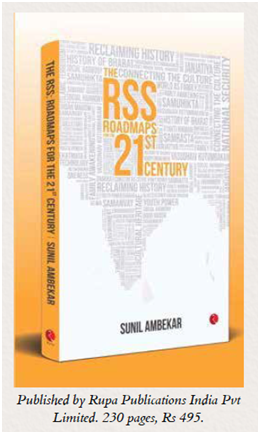 During the Nehruvian era, the Rashtriya Swayamsevak Sangh (RSS) was an easy target, a kind of universal whipping boy. The book aims at dispelling the wrong notions associated with the RSS. It is not just a roadmap of the RSS; it is also a revealing book written by a person who knows this organization from within and therefore it has greater authenticity and credibility. It is largely inspired by the visions of RSS and partly based on the firsthand experiences of Sunil Ambekar. It is free from bias for it gives only facts and facts not of the Gradgrindian (Charles Dickens) type rather those that were "half hidden from the eye".
During the Nehruvian era, the Rashtriya Swayamsevak Sangh (RSS) was an easy target, a kind of universal whipping boy. The book aims at dispelling the wrong notions associated with the RSS. It is not just a roadmap of the RSS; it is also a revealing book written by a person who knows this organization from within and therefore it has greater authenticity and credibility. It is largely inspired by the visions of RSS and partly based on the firsthand experiences of Sunil Ambekar. It is free from bias for it gives only facts and facts not of the Gradgrindian (Charles Dickens) type rather those that were "half hidden from the eye".
The book underpins the process through which the RSS is recontextualising age old civilisational thoughts in an ever-changing contemporary society. It depicts the 94 years of its journey through “thunderstorm and rain” and that it has not deviated from its goal to make the country strong.
According to the writer, the RSS strongly advocates the principles of easy friendship and genuine brotherhood. One of its fundamental principle is ‘seva’ or devotional service to the motherland. It is a forward-looking, futuristic organization. The book is not just a blueprint of the RSS for here the writer analyses its philosophy, basic thoughts and programmes. He emphasizes that the use of the word ‘Hindu Rashtra’ does not mean others have no status. It looks at all Indians with the same respect and understanding. On 6 January 1948, Sardar Patel significantly wrote that the swayamsevaks are "patriots and they love their motherland". Ambekar emphatically says that the RSS has just one goal – making India great.
The book comprises 10 chapters along with an introduction and an epilogue and it absorbingly unravels invaluable pieces of information which generally remain hidden from public domain. There are certain chapters which have been focused at length. For example, in the fourth chapter, ‘The History of Bharat’, the writer tells us that how those opposed to Bharat connived at and wrote a highly distorted history of our country. Consequently, most of the history books contain only a minuscule of truth because these have been written by the “Marxists and Macaulayists”. They looked at India from a cracked lens, coloured by ideology rather than facts. That is why the picture of India as given in the history textbooks is not only defective, but also deliberately misleading.
According to Ambekar, the year 1857 was not just a sepoy mutiny rather it was India's first war of independence. But strangely, according to the writer, in all history books there is practically a total eclipse of the tribal history. Tilka Manji, as Ambekar says, was the first janjati (tribal) among the Santhals who took up arms against the British in 1875. So was Budhu Bhagat, the Oraon leader, who resisted in 1832 for independence. Birsa Munda, to take another example, the first tribal revolutionary, fought against the British Government and the church. He died in Ranchi jail in 1900. The writer also mentions that Rani Durgawati, “who fought against the conquest of Akbar” is absent in school textbooks. There is a design in the school textbooks written by these historians and as the writer very aptly observes they have "no conscience towards their country".
To read the further articles please get your copy of Eastern Panorama December issue @http://www.magzter.com/IN/Hill-Publications/Eastern-Panorama/News/ or mail to contact @easternpanorama.in


